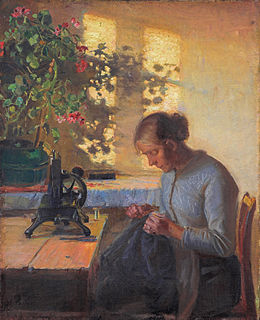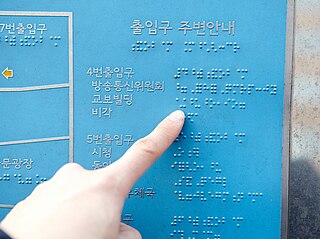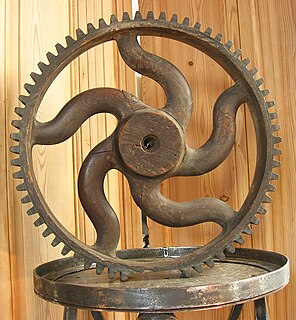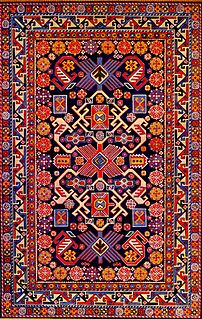
Knitting is a method by which yarn is manipulated to create a textile or fabric; it is used in many types of garments. Knitting may be done by hand or by machine.

Pattern welding is the practice in sword and knife making of forming a blade of several metal pieces of differing composition that are forge-welded together and twisted and manipulated to form a pattern. Often mistakenly called Damascus steel, blades forged in this manner often display bands of slightly different patterning along their entire length. These bands can be highlighted for cosmetic purposes by proper polishing or acid etching. Pattern welding was an outgrowth of laminated or piled steel, a similar technique used to combine steels of different carbon contents, providing a desired mix of hardness and toughness. Although modern steelmaking processes negate the need to blend different steels, pattern welded steel is still used by custom knifemakers for the cosmetic effects it produces.

Quilting is the process of sewing two or more layers of fabric together to make a thicker padded material, usually to create a quilt or quilted garment. Typically, quilting is done with three layers: the top fabric or quilt top, batting or insulating material and backing material, but many different styles are adopted.

A pattern is a regularity in the world, in human-made design, or in abstract ideas. As such, the elements of a pattern repeat in a predictable manner. A geometric pattern is a kind of pattern formed of geometric shapes and typically repeated like a wallpaper design.

Sewing is the craft of fastening or attaching objects using stitches made with a needle and thread. Sewing is one of the oldest of the textile arts, arising in the Paleolithic era. Before the invention of spinning yarn or weaving fabric, archaeologists believe Stone Age people across Europe and Asia sewed fur and skin clothing using bone, antler or ivory needles and "thread" made of various animal body parts including sinew, catgut, and veins.

Batik is a technique of wax-resist dyeing applied to whole cloth. This technique originated from Indonesia. Batik is made either by drawing dots and lines of the resist with a spouted tool called a tjanting, or by printing the resist with a copper stamp called a cap. The applied wax resists dyes and therefore allows the artisan to colour selectively by soaking the cloth in one colour, removing the wax with boiling water, and repeating if multiple colours are desired.

Rangoli is an art form, originating in the Indian subcontinent, in which patterns are created on the floor or the ground using materials such as colored rice, dry flour, colored sand or flower petals. It is usually made during Diwali or Tihar, Onam, Pongal and other Hindu festivals in the Indian subcontinent. Designs are passed from one generation to the next, keeping both the art form and the tradition alive.
Fretwork is an interlaced decorative design that is either carved in low relief on a solid background, or cut out with a fretsaw, coping saw, jigsaw or scroll saw. Most fretwork patterns are geometric in design. The materials most commonly used are wood and metal. Fretwork is used to adorn furniture and musical instruments. The term is also used for tracery on glazed windows and doors. Fretwork is also used to adorn/decorate architecture, where specific elements of decor are named according to their use such as eave bracket, gable fretwork or baluster fretwork, which may be of metal, especially cast iron or aluminum.

In sewing and fashion design, a pattern is the template from which the parts of a garment are traced onto fabric before being cut out and assembled. Patterns are usually made of paper, and are sometimes made of sturdier materials like paperboard or cardboard if they need to be more robust to withstand repeated use. The process of making or cutting patterns is sometimes condensed to the one-word Patternmaking, but it can also be written pattern(-)making or pattern cutting.

Korean Braille is the braille alphabet of the Korean language. It is not graphically-related to other braille scripts found around the world. Instead, it reflects the patterns found in hangul, and differentiates initial consonants, vowels, and final consonants.

A foundry is a factory that produces metal castings. Metals are cast into shapes by melting them into a liquid, pouring the metal into a mold, and removing the mold material after the metal has solidified as it cools. The most common metals processed are aluminium and cast iron. However, other metals, such as bronze, brass, steel, magnesium, and zinc, are also used to produce castings in foundries. In this process, parts of desired shapes and sizes can be formed.

Chevron beads are special glass beads; the first specimens of this type were created by glass bead makers in Venice and Murano, Italy, toward the end of the 14th century. They may also be referred to as rosetta, or star beads. The term rosetta first appeared in the inventory of the Barovier Glass works in Murano, in 1496, in context with beads as well as with other glass objects.
Knitted fabric is a textile that results from knitting. Its properties are distinct from woven fabric in that it is more flexible and can be more readily constructed into smaller pieces, making it ideal for socks and hats.

In casting, a pattern is a replica of the object to be cast, used to prepare the cavity into which molten material will be poured during the casting process.

Origami paper is used to fold origami, the art of paper folding. The only real requirement of the folding medium is that it must be able to hold a crease, but should ideally also be thinner than regular paper for convenience when multiple folds over the same small paper area are required.
The Fostoria Glass Company manufactured pressed, blown and hand-molded glassware and tableware for almost 100 years. It began operations in Fostoria, Ohio, on December 15, 1887, on land donated by the townspeople. The new company was formed by men from West Virginia, who were experienced in the glassmaking business. They started their company in northwest Ohio to take advantage of newly discovered natural gas that was an ideal fuel for glassmaking. Numerous other businesses were started in the area, and the supply of natural gas began to diminish. Fuel shortages caused the company to move to Moundsville, West Virginia in 1891.
On the technical analysis chart, a wedge pattern is a market trend commonly found in traded assets. The pattern is characterized by a contracting range in prices coupled with an upward trend in prices or a downward trend in prices.

Azerbaijani rugs are a product of Azerbaijan, an ancient center of carpet weaving. The Azerbaijani rug is a traditional handmade textile of various sizes, with dense texture and a pile or pile-less surface, whose patterns are characteristic of Azerbaijan's many carpet-making regions. Traditionally, since ancient times the carpets were used in Azerbaijan to cover floors, decorate interior walls, sofas, chairs, beds and tables.

Islamic decoration, which tends to avoid using figurative images, makes frequent use of geometric patterns which have developed over the centuries.

Kogin-zashi (こぎん刺し) is one of the techniques of sashiko, or decorative reinforcement stitching, that originated in the part of present-day Aomori Prefecture, Japan, that was controlled by the Tsugaru clan during the Edo period. It is also referred to as "sashi-kogin". It is generally made with white cotton embroidery in diamond patterns on blue linens. During the Edo period, peasants were not permitted to wear cotton cloth in the Tsugaru region, so cotton thread was added to linen cloth with the aim of bypassing these regulations and making clothes more protective during the harsh winter weather, as well as strengthening the cloth.















